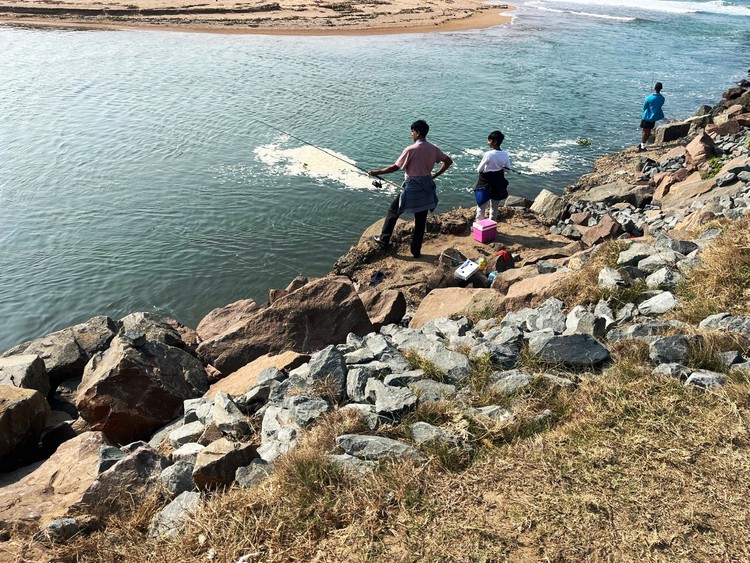
18 July 2024
The Umgeni River mouth is a popular recreation area in Durban, but is chronically polluted by sewage. Photo: Nokulunga Majola
Every day, failing eThekwini sewage plants pollute the Umgeni River with more than four million litres of sewage that has only been partially treated, adding to an already high pollution load.
Since 2022, water quality tests by Talbot laboratory and Adopt A River at points along the Umgeni River have consistently revealed alarming pollution levels, primarily from E. coli bacteria. The river, renowned for its scenic path from the KwaZulu-Natal Midlands to Durban’s Blue Lagoon, has long been a venue for events like the Duzi Canoe Marathon which finishes at the Umgeni River mouth, attracting paddlers and tourists alike.
There are two eThekwini sewage treatment works releasing effluent into the Umgeni River: the Fredville Wastewater Treatment Works (WWTW), and the much larger Northern WWTW. Both fail to meet minimum compliance standards for sewage treatment, according to the Department of Water and Sanitation’s own data.
Tests at the point where the Northern Wastewater Treatment Works releases effluent into the river, as well as further downstream at Riverside, and at the Kingfisher Canoe Club where the river mouth forms the Blue Lagoon, reveal longstanding serious sewage pollution.
Water quality tests over the last six months show levels of E.coli - a bacteria found in human faeces and an indicator of sewage pollution - are consistently thousands of times above the acceptable level.
E.coli is measured as colony forming units (cfu) per 100ml. At the Northern WWTW, analysis of samples taken on 15 February, 20 June, and 4 July show millions of E.coli cfu per 100ml. Yet national guidelines published by the Department of Water and Sanitation state that effluent released from WWTWs must not contain more than 1,000cfu/100ml for E.coli. This suggests that sewage entering the Northern WWTW is not being properly treated before being released into the river.
This is confirmed by the Department of Water and Sanitation’s Integrated Regulatory Information System (IRIS) which reflects monthly test results of WWTW effluent. It shows the Northern WWTW has been failing to properly treat sewage since 2016, which is as far back as the data goes.
Water quality standards for safe swimming allow for up to 130 cfu of E.coli/100ml, above which the risk of gastrointestinal illness increases. The eThekwini municipality closes the beaches if E.coli readings are above 500. Readings of up to 500 are generally accepted as being suitable for intermediate water contact activities, such as canoeing, windsurfing, or angling.
But the water samples taken just downstream from the Northern WWTW have had E.coli counts in the millions over the last six months. On 4 July the count was 3,448,000cfu/100ml. The count was 1,274,000 on 20 June, and 2,419,600 on 15 February. On other occasions the results are near the 500,000 mark.
Municipal spokesperson Gugu Sisilana told GroundUp the primary source of pollution in the Umgeni is sewer overflows caused by blockages and vandalised infrastructure, as well as “illegal connections”. And 90% of these, stated Sisilana, are caused by residents “misusing the system” by dumping “foreign objects” into the sewerage. These include rags, building rubble, nappies, oils and fats.
At other testing sites, such as the Kingfisher Canoe Club situated where the Umgeni forms the Blue Lagoon before entering the sea, E. coli readings have often been in the tens of thousands, reaching 2,064,000cfu/100ml on 13 June.
Durban North resident Rick Kennedy said the state of the Umgeni River was “a disgrace”.
“My friends used to paddle in the river, but they got sick and stopped due to the pollution. I’ve seen dead fish and birds, and sometimes excrement flows from the river, which is disheartening,” said Kennedy.
Environmental experts warn that the river’s compromised health not only jeopardises local biodiversity but also poses significant health risks to humans through contaminated water sources and degraded ecosystems.
Wile Jonathan Erasmus, Manager of WaterCAN in KwaZulu-Natal said the water quality test results speak for themselves.
Contrary to Sisilana’s assertion that the primary source of pollution in the river was blocked and overflowing sewerage infrastructure which was caused by residents, Erasmus said the primary cause was the Northern WWTW.
“Until this is fixed, we will alway have high E.coli in the river,” he said.
Litterboom Project media manager Casey Pratt said the river ecosystem was being severely affected by pollution and was unsafe for recreational activities.
“Sewage overflows and untreated waste introduce harmful bacteria and viruses into the water, posing health risks to humans and animals,” said Pratt.
“It leads to chemical pollution, nutrient overload, and increased turbidity, all of which degrade the water quality. The ecosystem suffers from loss of biodiversity, fish and aquatic life mortality, degraded habitats, and damaged estuarine environments,” she said.
Sisilana said contamination of the Umgeni River had significantly affected recreational activities and tourism in the city, and the municipality was urging residents not to abuse the sewer infrastructure, and repairing damaged and blocked sewer lines reported by residents or identified by municipal staff.
She said the municipality was also repairing wastewater treatment works damaged by floods, as well as “implementing functional upgrades and planned improvements for other plants”.
Sisilana said the municipality routinely monitors water quality at Blue Lagoon, and beaches are closed when water quality does not meet minimum standards.